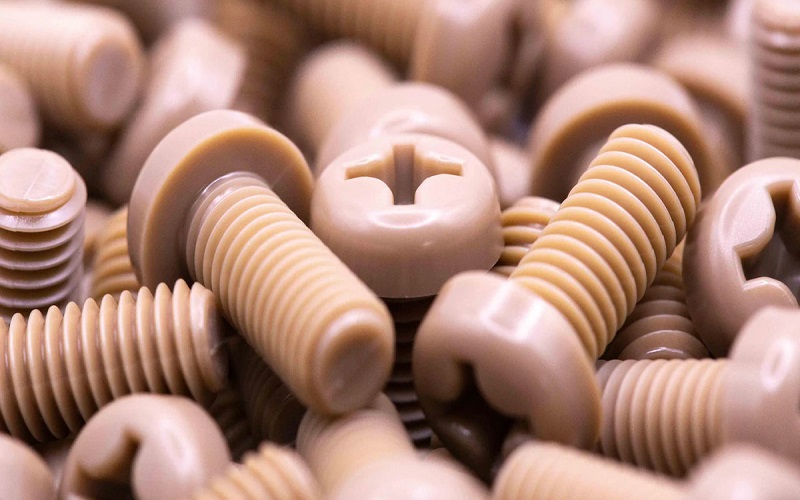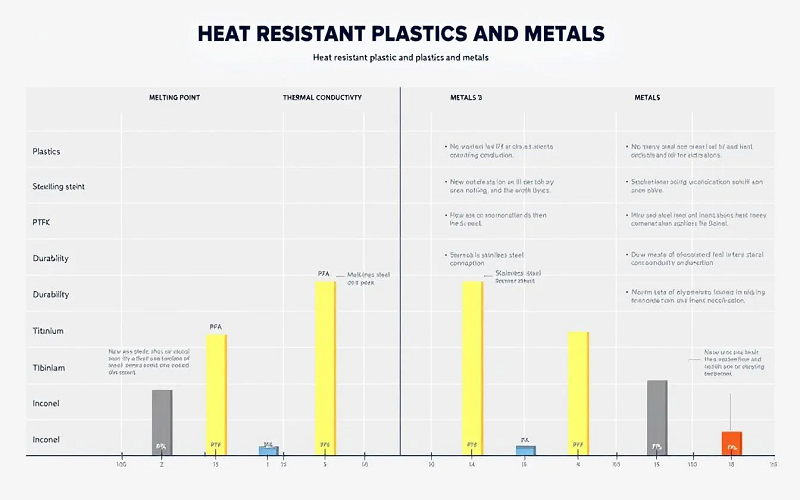When your application involves high temperatures, choosing the right heat resistant plastic materials is critical. This guide explores how these specialized plastics can withstand extreme conditions, types of heat resistant materials available, and where they are most effectively used.
Understanding Heat Resistant Plastics

Heat-resistant plastics stand out due to their ability to maintain stability and mechanical integrity at elevated temperatures. These materials are crucial in applications where high temperatures could compromise standard plastics. The Heat Deflection Temperature (HDT) is a key measure, indicating how well a plastic retains stiffness under a load when subjected to high temperatures.
Continuous operating temperature is another critical metric, representing the maximum temperature a plastic can endure over extended periods while maintaining its properties.
In many cases, these materials offer a large operating temperature range, performing reliably not only in high-heat conditions but also in cold temperatures, where conventional plastics might become brittle or lose functionality.
The molecular structure of these plastics significantly influences their heat resistance:
- Amorphous plastics lack a defined melting point and gradually soften.
- Semi-crystalline plastics have a specific melting point.
- Adding rigid aromatic rings to the resin enhances heat resistance in thermoplastics.
- The chemical backbone of these materials is designed to withstand extreme temperatures, ensuring they perform well even under harsh conditions.
Choosing the right high-temperature plastic involves considering:
- Operating temperature
- Mechanical strength
- Chemical exposure
- Manufacturing method, as some materials are better suited for machining, while others excel in injection molding
- Cost, noting that high-performance materials like PEEK offer excellent heat resistance but at a higher price point.
Top 5 Heat Resistant Plastics and Their Applications
Heat-resistant plastics are essential in high-temperature applications across various industries. The top five materials are:
- Polyetherimide (PEI)
- Polyether Ether Ketone (PEEK)
- Polytetrafluoroethylene (PTFE)
- Polybenzimidazole (PBI)
- Polyphenylene Sulfide (PPS)
Each offers unique properties and benefits. These high performance thermoplastic and high temperature polymers, along with high performance plastics and high performance polymer, can retain structural capabilities above 150°C and short-term above 250°C, making them invaluable in sectors like automotive, aerospace, and semiconductor. Key thermal characteristics, such as glass transition temperature, help determine the temperature at which these materials begin to lose their rigidity, making it a crucial parameter in material selection.
These plastics also exhibit excellent thermal resistance, chemical resistance, and corrosion resistance, making them ideal for demanding applications. In addition, many of them are classified as engineering plastics, known for their superior mechanical and thermal properties.
Certain grades also offer radiation resistance, enabling their use in nuclear, medical, and space applications. Let’s delve into the specifics of each material to understand their unique properties and applications.
Polyetherimide (PEI) – ULTEM®
Polyetherimide (PEI), known by its brand name ULTEM®, is renowned for its high performance in various high-temperature applications. Featuring the highest tensile strength, favorable chemical and temperature resistance, and high dielectric strength, PEI is a top choice for many industries. Typical applications consist of electrical circuit boards and sterilizable medical equipment. They also include food processing equipment and aircraft components.
Despite its numerous advantages, PEI can crack in the presence of polar chlorinated solvents, and its relatively high cost may be a drawback for some applications. However, its maximum continuous operating temperature of 340°F (171°C) makes it a valuable asset in environments requiring high thermal stability.
Polyether Ether Ketone (PEEK)
Polyether Ether Ketone (PEEK) is another high-performance plastic known for its excellent thermal and chemical resistance. It is widely used in the medical and automotive industries, where its ability to withstand high temperatures and chemical exposure is crucial. PEEK can be sterilized in an autoclave, making it suitable for medical devices such as catheters.
However, PEEK is costly and exhibits poor UV resistance, which can limit its applications. Its melting point of 482°F (250°C) underscores its thermal stability, making it ideal for high-temperature environments.

Polytetrafluoroethylene (PTFE) – Teflon®
Polytetrafluoroethylene (PTFE), commonly known as Teflon, is celebrated for its high corrosion resistance and low friction properties. These characteristics make it an excellent material for non-stick cookware and other applications requiring a smooth, frictionless surface.
PTFE is widely used in various industries, including electronics and aerospace, where its chemically inert properties and thermal stability are highly valued.
Polybenzimidazole (PBI)
Polybenzimidazole (PBI) is distinguished as the most heat-resistant thermoplastic available, making it indispensable in applications requiring extreme thermal stability. Its exceptional heat resistance makes it a top choice in aerospace and other industries where high temperatures are a constant challenge.
Polyphenylene Sulfide (PPS)
Polyphenylene Sulfide (PPS) stands out for its semi-crystalline structure, which enhances its flame resistance and chemical resistance. Widely used in industrial electrical components and automotive components, PPS offers excellent dimensional stability and can withstand harsh chemical environments.
Its working temperature of 428°F (220°C) makes it suitable for high-temperature applications.
Comparing Heat Resistant Plastics to Metals

Heat-resistant plastics offer several advantages over metals, particularly in industries like aerospace and automotive where weight reduction is crucial. These plastics are significantly lighter than metals, which can enhance fuel economy and improve handling.
While metals typically have higher maximum operating temperatures, heat-resistant plastics excel in reducing weight and maintaining mechanical properties under extreme conditions, making them a viable option for metal replacement.
One of the standout benefits of heat-resistant plastics is their corrosion resistance, making them ideal for environments where metals might corrode. However, metals generally possess superior thermal conductivity, making them better suited for applications requiring rapid heat dissipation.
Heat-resistant plastics, other plastics can retain their excellent mechanical properties and thermal properties even in harsh chemicals environments, offering a durable and light weight alternative to traditional materials and the right material for various applications that are highly resistant, wear resistant, and provide metal like durability, while also demonstrating wear resistance and can withstand temperatures.
Methods to Enhance Heat Resistance in Plastics

Enhancing the heat resistance of plastics involves several techniques. One common method is blending low heat-resistant resins with high heat-resistant ones to boost thermal properties while retaining other beneficial characteristics, such as creep resistance. Cross-linking technology, which creates intermolecular bonds, can also enhance heat resistance in materials like HDPE and PVC, improving their performance under low temperatures.
Modifying the molecular structure of plastics or blending them with metal alloys is another effective approach to improving thermal properties. Adding inorganic fillers such as talcum powder can further enhance heat resistance, stability, creep resistance, and mechanical strength.
Continuous Service Temperature is a crucial metric, indicating the maximum temperature at which a plastic can retain at least 50% of its properties after prolonged exposure.
Choosing the Right Heat Resistant Plastic for Your Application
Selecting the right heat-resistant plastic involves considering several factors, including the melting point, environment, load case, and economic constraints. The specific application will dictate the best material selection. High-temperature thermoplastics can be significantly more expensive than general-purpose plastics, so cost is an essential factor.
Engineers can improve the heat resistance of plastics by using additives and heat stabilizers. Common additives include:
- Antioxidants
- Flame retardants
- Processing aids These additives help enhance the material’s thermal stability. Heat stabilizers are particularly useful in protecting polymers from heat damage, preserving their strength and elasticity
Innovative Applications of Heat Resistant Plastics

Heat-resistant plastics are at the forefront of innovation in several industries. In aerospace, these materials are used for engine components and thermal insulation, providing high temperature stability in inert environments and reducing overall weight.
Heat-resistant plastics contribute to enhanced fuel efficiency in the automotive sector by reducing vehicle weight while tolerating high temperatures and forming two chemical links for improved structural integrity.
Medical applications also benefit significantly from these plastic materials. Heat-resistant plastics are used in surgical instruments and healthcare devices within the medical industry, where they endure the rigors of sterilization processes in inert environments and maintain durability through robust two chemical links.
These advanced applications demonstrate the versatility and importance of heat-resistant plastics in modern industry.
Summary
Heat-resistant plastics are revolutionizing various industries by offering materials that can withstand extreme temperatures without compromising performance. From aerospace to medical applications, these materials provide unmatched thermal stability, chemical resistance, and mechanical integrity.
By understanding the properties and applications of the top heat-resistant plastics, you can make informed decisions about which material is best suited for your specific needs. The future of high-temperature applications looks bright with these advanced materials at the forefront.
Frequently Asked Questions
What are heat-resistant plastics?
Heat-resistant plastics are materials capable of maintaining their stability and structural integrity under elevated temperatures, ensuring their suitability for high-temperature applications.
What industries commonly use heat-resistant plastics?
Heat-resistant plastics are commonly utilized in the aerospace, automotive, medical, and electronics industries because of their superior thermal stability and durability.
What is the Heat Deflection Temperature (HDT)?
The Heat Deflection Temperature (HDT) is a crucial metric that indicates how well a plastic material maintains its stiffness when exposed to elevated temperatures while under load. Understanding HDT is essential for selecting materials that will perform reliably in high-temperature applications.
How can the heat resistance of plastics be enhanced?
The heat resistance of plastics can be enhanced through methods such as blending resins, utilizing cross-linking technology, modifying molecular structures, and incorporating inorganic fillers. These approaches effectively improve the material’s thermal stability and performance.
What factors should be considered when selecting a heat-resistant plastic?
When selecting a heat-resistant plastic, it is essential to consider the material’s melting point, the operating environment, load conditions, economic factors, and specific application requirements. These factors will ensure optimal performance and durability of the plastic in its intended use.

